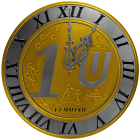
|

|
|
VERIFY COINS YOURSELF
The most important feature of the new financial system is that there is no trusted central institute that validates a transaction. Each participant has the responsibility to do this verification themselves each time he enters a transaction. This is because not verifying the coins you receive (with your app) could lead to loss off the value of these coins. Because others that do the research might find out the coins are not legit and refuse to accept them from you, which leads to these coins to eventually devalue to 0. When you verify the coins of others, you basically check where the coins - the other person owns – came from. There are 2 possibilities:
HOW TO ORIGINATE COINS? Each participant holds a originating overview which is stored in his personal blockchain where all the transactions and details of its origins can be found. At any given moment the devalued value of all coins can be determined. If you received 100 coins 5000 hours ago, then the current value is 100 x (0.99995^5000). But when a cent or more of value is remaining, it still is important to find out who the person was that “originated” that (portion) of a coin. So what you want to do is go through all the relevant blockchains that are collected to find out (by cross-checking) if all coins were originated by people with just one identity. Next to that you also want to check this for all the people that didn’t originate that coin, but just used those received coins to purchase something. Originating is nothing else than collecting a lot of relevant personal blockchains and ID-Cards and follow the various coins trails. USE OLD OR NEW COINS? Because all coins devalue at the same rate, it really doesn't matter if you use coins that were created long ago or that are created recently. Not using coins seems perhaps strange, but the only way to prevent coins from devaluing is not having coins. Therefor it simply doesn’t make a difference which coins devalue in your wallet. For risk purposes it is smart to use coins from people you really know and avoid coins with little overlap with your well known transaction partners: ACCEPTANCE SECURITY It’s best to receive the most secure coins:
HOW MANY DIFFERENT ORIGINATED COINS PER TRANSACTION> In theory this could be without limits. Having no restrictions on the number of coins with different origins, would however make the blockchain unnecessarily long. To start, the app is restricted to allow a maximum of 5 different originated coins, next to the self-originated coins of the sender of the coins. It seems important that at every transaction a certain portion of the self-originated coins of the sender of the money should be included in every transaction. |